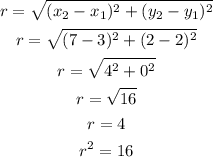Step-by-step explanation:
The coordinate of the center is given below as

From the image below
The general equation of a circle is represented below as

To figure out the value for r, we will use the formula below

By substituting the values, we will have

Hence,
The final answer by substituting the center and the radius will be given below as

Hence,
The final answer is
